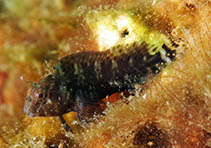http://www.fishbase.org/Summary/speciesSummary.php?genusname=Hypleurochilus&speciesname=caudovittatus ---> http://52.67.158.155/Summary/speciesSummary.php?genusname=Hypleurochilus&speciesname=caudovittatus
http://52.67.158.155/Summary/speciesSummary.php?genusname=Hypleurochilus&speciesname=caudovittatus ---> https://fishbase.net.br/Summary/speciesSummary.php?genusname=Hypleurochilus&speciesname=caudovittatus
https://fishbase.net.br/Summary/speciesSummary.php?genusname=Hypleurochilus&speciesname=caudovittatus ---> https://fishbase.net.br/summary/Hypleurochilus-caudovittatus.html
Hypleurochilus caudovittatus, Zebratail blenny

You can
sponsor
this page
Common name (e.g. trout)
Genus + Species (e.g. Gadus morhua)
-

-
About this page
-
Languages
-
User feedbacks
-
Citation
-
Uploads
-
Related species
-


 Zebratail blenny
Add your observation in
Fish Watcher
Upload your
photos
and
videos
Zebratail blenny
Add your observation in
Fish Watcher
Upload your
photos
and
videos
Pictures
|
Google image
 Hypleurochilus caudovittatus
Hypleurochilus caudovittatus
Picture by
Cox, C.D.
Teleostei (teleosts) >
Blenniiformes
(Blennies) >
Blenniidae
(Combtooth blennies) > Salariinae
Etymology:
Hypleurochilus:
Greek, hypo = under + Greek, pleura = in the side of + Greek, cheilos = lip
.
Environment: milieu / climate zone / depth range / distribution range
Ecology
Marine; brackish; reef-associated. Subtropical
Western Central Atlantic: USA.
Size / Weight / Age
Maturity: L
m
?
range ? - ? cm
Max length : 5.9 cm SL male/unsexed; (Ref.
52938
)
Short description
Morphology
|
Morphometrics
Dorsal
spines
(total): 12;
Anal
spines
: 2;
Anal
soft rays
: 16. Species distinguished by: caudal fin with 3 or 4 dark bands on translucent background; segmented caudal-fin soft rays usually 13; segmented anal-fin rays usually 16 (west coast of Florida); pelvic fins with 1 spine and 3 soft rays; dorsal fin not separated into 2 portions by deep notch; dorsal-fin spines usually 12, the last easy to see; total dorsal-fin elements 25 to 30; pectoral-fin soft rays usually 13 or 14; no teeth on vomer; an enlarged canine tooth present posteriorly on both sides of 1 or both jaws (sometimes absent on 1 side); gill openings not continuous, each restricted to side of head, extending ventrally to about midlevel of pectoral-fin base or further; cirri present only on eyes; ventral edge of upper lip smooth; lateral line never consisting of 2 disconnected, overlapping portions. Common amongst Blenniids: small, slender fishes, largest species to about 13 cm SL, most under 7.5 cm SL. Eyes high on sides of head; mouth ventral, upper jaw not protractile. A single row of incisor-like teeth in each jaw and often an enlarged canine-like tooth posteriorly on each side of lower jaw and sometimes upper jaw; no teeth on palatines. Dorsal and anal fins long, their spines usually flexible; dorsal fin with fewer spines than segmented (soft) rays; 2 spines in anal fin, scarcely differentiated from the segmented rays, the first not visible in females, both often supporting fleshy, bulbous, rugose swellings at their tips in males; pelvic fins inserted anterior to base of pectoral fins, with 1 spine (not visible) and segmented rays; all segmented fin rays, except those of caudal fin, unbranched (simple), caudal-fin rays of adults branched. All species lack scales (Ref.52855).
Oviparous. Eggs are demersal and adhesive (Ref.
205
), and are attached to the substrate via a filamentous, adhesive pad or pedestal (Ref.
94114
). Larvae are planktonic, often found in shallow, coastal waters (Ref.
94114
).
Life cycle and mating behavior
Maturity
|
Reproduction
|
Spawning
|
Eggs
|
Fecundity
|
Larvae
Oviparous, distinct pairing (Ref.
205
).
Eschmeyer, W.N. (ed.)
, 2003. Catalog of fishes. Updated database version of March 2003. Catalog databases as made available to FishBase in March 2003. (Ref.
46206
)
IUCN Red List Status (Ref.
130435
)
Least Concern (LC)
; Date assessed:
11 August 2011
CITES
Not Evaluated
Not Evaluated
Threat to humans
Harmless
Human uses
FAO - Publication:
search
|
FishSource
|
More information
Countries
FAO areas
Ecosystems
Occurrences
Introductions
Stocks
Ecology
Diet
Food items
Food consumption
Ration
Common names
Synonyms
Metabolism
Predators
Ecotoxicology
Reproduction
Maturity
Spawning
Spawning aggregation
Fecundity
Eggs
Egg development
Age/Size
Growth
Length-weight
Length-length
Length-frequencies
Morphometrics
Morphology
Larvae
Larval dynamics
Recruitment
Abundance
BRUVS
References
Aquaculture
Aquaculture profile
Strains
Genetics
Electrophoreses
Heritability
Diseases
Processing
Nutrients
Mass conversion
Collaborators
Pictures
Stamps, Coins Misc.
Sounds
Ciguatera
Speed
Swim. type
Gill area
Otoliths
Brains
Vision
Tools
E-book
|
Field guide
|
Identification keys
|
Length-frequency wizard
|
Life-history tool
|
Point map
|
Classification Tree
|
Catch-MSY
|
Special reports
Check for Aquarium maintenance
|
Check for Species Fact Sheets
|
Check for Aquaculture Fact Sheets
Download XML
Summary page
|
Point data
|
Common names
|
Photos
Internet sources
AFORO (otoliths) |
Aquatic Commons
|
BHL
|
Cloffa
|
BOLDSystems
|
Websites from users
|
Check FishWatcher
|
CISTI
|
Catalog of Fishes
:
genus
,
species
|
DiscoverLife
|
ECOTOX
| FAO - Publication:
search
|
Faunafri
| Fishipedia |
Fishtrace
| GenBank:
genome
,
nucleotide
| GloBI |
Google Books
|
Google Scholar
|
Google
| IGFA World Record |
MitoFish
|
Otolith Atlas of Taiwan Fishes
|
PubMed
|
Reef Life Survey
| Socotra Atlas |
Tree of Life
| Wikipedia:
Go
,
Search
| World Records Freshwater Fishing |
Zoobank
|
Zoological Record
Estimates based on models
Preferred temperature (Ref.
123201
): 23.3 - 27.1, mean 24.9 °C (based on 109 cells).
Phylogenetic diversity index (Ref.
82804
): PD
50
= 0.5005 [Uniqueness, from 0.5 = low to 2.0 = high].
Bayesian length-weight: a=0.00741 (0.00335 - 0.01640), b=3.02 (2.83 - 3.21), in cm total length, based on LWR estimates for this (Sub)family-body shape (Ref.
93245
).
Trophic level (Ref.
69278
): 3.2 ±0.3 se; based on size and trophs of closest relatives
Resilience (Ref.
120179
): High, minimum population doubling time less than 15 months (Preliminary K or Fecundity.).
Fishing Vulnerability (Ref.
59153
): Low vulnerability (10 of 100).
Back to Search
Random Species
Back to Top
Accessed through:
Not available
FishBase mirror site :
Laguna, Philippines
Page last modified by :
mrius-barile
|